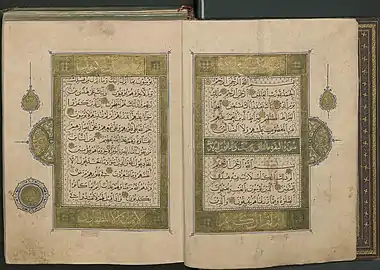Rayhani script
Reyhan or Rayḥānī (Arabic: ریحان) is one of the six canonical scripts of Perso-Arabic calligraphy. The word Reyhan means basil in Arabic and Persian. Reyhan is considered a finer variant of Muhaqqaq script, likened to flowers and leaves of basil.[1]
.jpg.webp)
Double-page from the Qur'an copied by 'Abd al-Rahman b. Abi Bakr b 'Abd al-Rahman al-Katib al-Maliki, called Zarin Qalam (Golden Pen). Each page of this manuscript has nineteen lines of text; the first, tenth, and nineteenth lines are written in muhaqqaq, and the two blocks sandwiched in between each comprise eight lines in rayhani. Iran, 1186. Chester Beatty Library

Opening pages from a Qur'an copied in rayhani by Yaqut al-Musta’simi. Baghdad, 1286/1287. Turkish and Islamic Arts Museum
.jpg.webp)
Double-page from a Mamluk Qur'an copied in rayhani by Ali ibn Muhammad al-Mukattib al-Ashrafi (attribution). Cairo, c. 1370–1375. British Library
Rayḥānī was developed during the Abbasid era by Ibn al-Bawwab.[2] Academic studies of Rayhani have included analytical study of the technical characteristics of Yaqut al-Musta’simi's method.[3]
References
- "معرفی خط ریحان". golestane.net. Retrieved 1 September 2015.
- الفخرو، إبراهيم بن يوسف (2015م). رحلة الخط العربي في ظلال المصحف الشريف (الطبعة الأولى). صفحة 100
- Nassar Mansour Yaqut al-Musta’simi, Analytical Study of the Technical Characteristics of his Method in Rayhani Script, (in Arabic), 2018, Jordan Journal of History and Archaeology
This article is issued from Wikipedia. The text is licensed under Creative Commons - Attribution - Sharealike. Additional terms may apply for the media files.